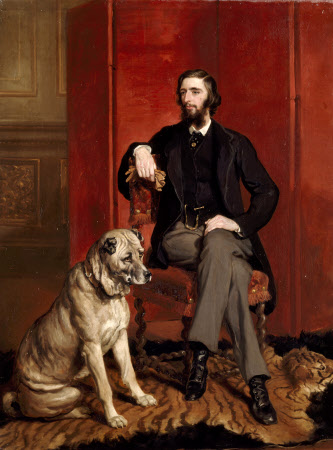John William Spencer Brownlow Egerton Cust, 2nd Earl Brownlow (1842-1867)
Sir Francis Grant PRA (Kilgraston 1803 - Melton Mowbray 1878)
Category
Art / Oil paintings
Date
1863
Materials
Oil on canvas
Measurements
1220 x 980 mm
Place of origin
England
Order this imageCollection
Belton House, Lincolnshire
NT 436077
Summary
Oil painting on canvas, John William Spencer Brownlow Egerton Cust, 2nd Earl Brownlow (1842-1867) by Sir Francis Grant PRA (Kilgraston 1803 - Melton Mowbray 1878). 1863. A full-length portrait, seated, facing, head turned slightly to the left, his legs crossed, left over right, and his right arm resting on the back of his chair, his gloves in his right hand, his left hand rests on his lap, he has dark brown hair, beard and moustache and is dressed in a black jacket, grey trousers, black shoes and black socks. Shown seated in an interior in front of a red screen with a large dog seated on the left, both of them are on a tiger skin, there is a view of the wall of the room to the left. Sir Francis Grant’s sitters-book, under July 1863: “Earl Brownlow. Small full length 210" (information kindly supplied by Dr. Catherine Wills). Painted to celebrate the sitter's majority. He was the eldest son of John Hume (Egerton-Cust), Viscount Alford (1812-51), and Lady Marian Compton (1817-88), daughter of the 2nd Marquess of Northampton; succeeded his grandfather as Earl Brownlow in 1853. In 1853 he changed his name to John William Spencer Brownlow Egerton and in 1863 he changed his name again to John William Spencer Brownlow Egerton-Cust. He was education at Eton and Christ Church, Oxford. The 2nd Earl was consumptive, and regularly went south with his mother, in search of better health. Her artistic bent may also have encouraged him to become an early practitioner of photography. He and his mother patronised the working-class Christian Socialist poet, Gerald Massey (1838-1907), and provided him with a house, Ward’s Hurst, on the Ashridge Estate. He died unmarried at Mentone, to which he had gone, like so many British, for the sake of his health, in February 1967. Massey wrote a threnody, In Memory of...Earl Brownlow, which was privately printed in 1869. He was succeeded, as 3rd Earl, by his robuster younger brother Adelbert Wellington Brownlow Cust (1844-1921) who married Lady Adelaide Talbot (1844/5-1917).
Credit line
Belton House, The Brownlow Collection (acquired with the help of the National Heritage Memorial Fund by the National Trust in 1984)
Makers and roles
Sir Francis Grant PRA (Kilgraston 1803 - Melton Mowbray 1878), artist

